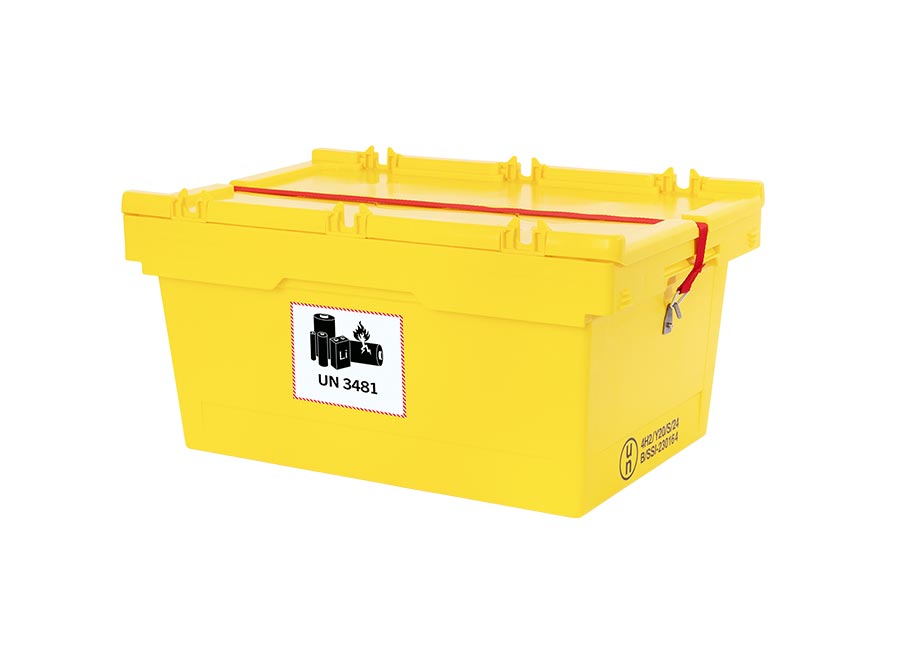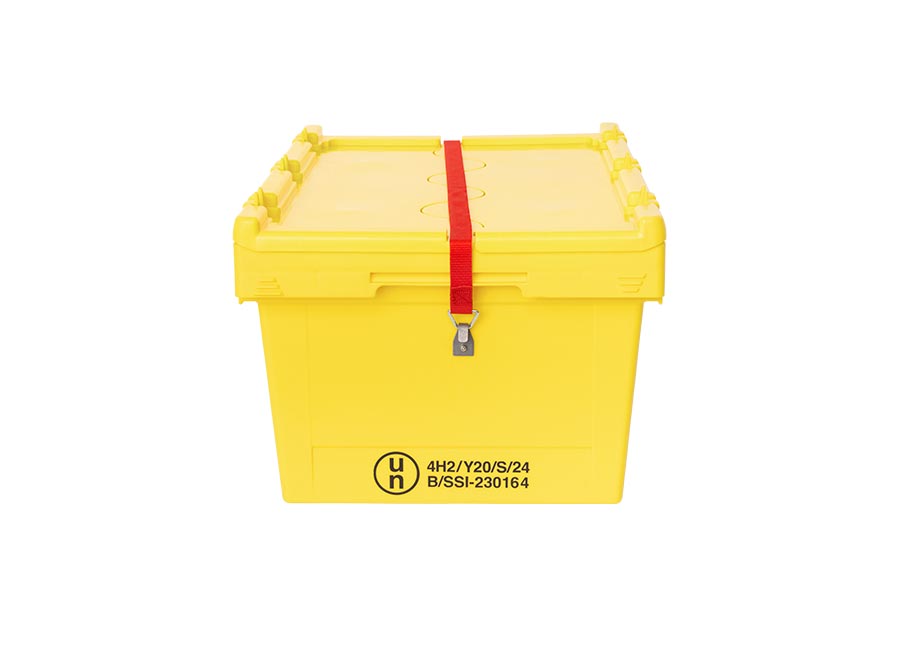
Dangerous goods container for lithium-ion batteries seCon KMB-DH627 GGV
The seCon KMB-DH627 GGV is a specially engineered dangerous goods container for the safe transport and controlled interim storage of lithium-ion batteries and comparable hazardous materials. The system combines a highly robust plastic construction with advanced fire protection expertise – developed as a partnership project between SSI Schäfer Plastics and Fingerhuth, bringing together long-standing know-how in plastic engineering with extensive experience in fire protection for lithium energy storage systems.
ADR-compliant for various battery conditions
The container complies with ADR P903, P908, P909 and P910 and is approved for a single battery. This makes it suitable for:
- new or used lithium-ion batteries
- damaged or defective energy storage units
- prototypes and test samples
- recycling and return logistics
Robust construction & efficient handling
The reinforced side walls and smooth base allow for a maximum total weight of 20 kg. For ergonomic handling, the seCon KMB-DH627 GGV is equipped with comfortable under-grip handles that ensure safe and convenient manipulation. When empty, the containers can be nested (stacked inside each other), reducing required storage space by up to 70% – a clear advantage for logistics companies and industrial users.
Sustainable materials with flame-retardant inner lining
The container is manufactured entirely from 100% recyclable polypropylene and designed for durable, long-term reuse. A flame-retardant inner lining, made by Fingerhuth, provides additional protection during the transport and storage of critical materials and supports the safety requirements associated with handling lithium-ion batteries.
Synergy of two industry experts
Through the collaboration between SSI Schäfer Plastics and Fingerhuth, a dangerous goods container has been created that combines the advantages of industrial plastic engineering with modern fire protection technology. This synergy ensures that the seCon KMB-DH627 GGV meets the highest technical and safety standards – ideal for companies requiring a reliable solution for handling lithium energy storage systems.
| Material container | Polypropylene (PP) |
| Dimensions L x W x H | 600 x 400 x 307 mm |
| Inner material | Flame-retardant insulating cushion made of high-temperature-resistant glass fibre |
| Transport approval | ADR, GGVSEB |
| UN number | 4H2/Y20/S/*/B/SSI-230164 |
| Load capacity | 20 kg |
| Dangerous material type | Lithium-ion batteries |
Technical Characteristics
The certified SECON KMB hazardous materials container for the safe handling of batteries and accumulators. Robust and flame-retardant materials combined with protection against short circuits – ideal for “yellow” batteries.
- Materials: Made from 100% recyclable polypropylene (PP). The interior is lined with a flame-retardant fiberglass cushion to contain fire hazards in the event of a thermal reaction.
- Load capacity / payload: The maximum permitted total weight is 20 kg. This allows for the transport of a relatively large number of batteries or cells, depending on their size.
- Secure closure & handling: The lid is two-part (hinged), making opening and handling easier. The lid is secured with a strap that prevents tampering or accidental opening. Ergonomic recessed grips ensure better handling. When empty, the containers can be nested inside each other, saving space (up to 70% storage space reduction). They can also be stacked when filled, optimizing space utilization during transport.
- Certification / hazardous goods compliance: UN-certified for all types of batteries (with printed “UN number”): this means the container meets the requirements for the transport of hazardous materials containing batteries. ADR-compliant according to regulations P903, P908, P909, P910.
- P903: new batteries
- P908: damaged batteries
- P909: batteries for recycling / return
- P910: intact batteries (depending on context)
- Safety: The flame-retardant interior lining (see cushion) protects against propagation in the event of a thermal reaction.
- Short-circuit protection: The padded and insulating interior structure reduces the risk of short circuits between battery terminals. (This is a logical assumption supported by the “hazardous goods: batteries” design and the ESD-related features mentioned on the manufacturer’s site.)
Application Examples
- Development / prototype production: In R&D laboratories where new battery cells or prototype batteries are tested: the KMB-DH627 can accommodate prototypes that may be unstable or not yet fully verified. Transport of test batteries between test benches, measuring equipment, and laboratories.
- Recycling / return: Collection container for defective or end-of-life lithium-ion batteries that are transported to a recycling facility. Since it is compliant with P909, it is well suited for recycling transport. Intermediate storage of batteries before they are shipped to recycling centers.
- Safe transport of damaged batteries: For batteries that are damaged or thermally unstable (e.g. after testing, overvoltage, or mechanical damage): the container provides protection and is approved according to P908.
- Use in recall campaigns: When batteries or electronic devices are returned by customers, they can be collected and transported in such certified containers.
- Storage in production / manufacturing: In production lines for e-mobility devices (e.g. e-bikes, drones), to safely store batteries before they are assembled or shipped.
- Intermediate storage for finished modules: When battery packs are manufactured, they can be temporarily stored in these containers before shipment.
- Transport to customers or logistics centers: As hazardous goods packaging for delivering batteries to customers or distribution centers, especially when handling larger, high-performance lithium-ion batteries subject to hazardous materials regulations. For service providers who need to transport batteries from one location to another (e.g. from assembly service to maintenance service).
- Emergency management: For securing damaged or discarded batteries until they can be safely transported for disposal or recycling. Discarded batteries that could potentially undergo a thermal reaction can be safely isolated.
Similar products






